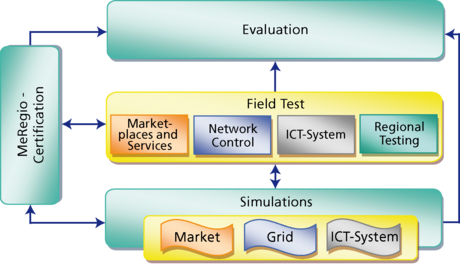Project Structure
The project is divided into four large areas, as is shown in the illustration below. While the main work of the participating industrial partners is the field test, the KIT is mainly involved in the analysis, simulation and development of concepts for each area.

Field Test
As part of the field test, a prototype of the marketplace, network control, and the ICT infrastructure will be established in four phases. KIT will act as an advisor and support its industrial partners in conception and evaluation later on. In the course of the project, a number of scenarios will be investigated and various concepts will be tested on the basis of the prototype and the model region.
Certification
An integral part of this project is a certificate for Minimum Emission Regions. KIT will develop the certificate and execute the certification process in the model region. This certificate will help creating awareness for the need to act in an energy-efficient way in both the population and (regional) politics and economy. Furthermore, certification will allow for regions to be compared with each other. In addition, a catalog of actions to enhance energy efficiency in the model regions will be drawn up.
To obtain as comprehensive information as possible on the energy efficiency of regions, energy sources other than electricity will also be taken into consideration during the certification process.
Simulations
Within the MeRegio project, simulation components will be used to closely examine and analyze various features of the MeRegio concepts. The KIT will develop appropriate simulation components and use them in the context of scenario analyses.
During the simulations, various levels and characteristics can be distinguished. As a part of the project, both offline and online simulations will be carried out in a real and a virtual model area. The real model comprises all participants in the model region. The virtual model area additionally covers other test participants distributed all over southern Germany. As the latter are not directly connected to the same low- and medium-voltage power grid as the participants in the real model area, integration will be simulated by means of software components. Virtual connection allows to create model areas of any composition as a basis of online and offline simulations.
Online simulations allow for the testing of different scenarios, such as various market mechanisms, grid control concepts, and business models, with the participants in the virtual or real model area. The online simulations interfere with the existing prototype and, thus, influence the model area. Offline simulations are necessary for the investigation of situations that cannot be induced in the real settings, such as power outages or consequences of extreme weather conditions. Offline simulations allow for the evaluation of a considerably larger number of approaches than the field test that is subject to time and technical restrictions.
The results of offline simulations will be used in the next project phases to choose the most promising MeRegio concepts which will then be implemented in the field test.
Evaluation
Within the scope of the evaluation process, the concepts developed will be analyzed and assessed. The main focus will be on issues relating to the operation of the prototype implemented. This includes effects on energy efficiency and greenhouse gas emissions and possible approaches to improving the overall system. Interest concentrates on the three objectives of efficiency, environmental compatibility, and security of supply. Additionally, legal framework conditions have to be investigated.
Success of the concepts developed is determined not only by their potential, but also by the participants‘ acceptance. From the results of various test runs and simulations, conclusions will be drawn with respect to consumer behavior, acceptance, and other socio-economic effects.
